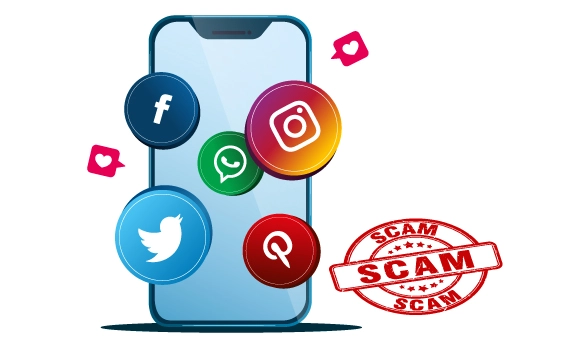LinkedIn is now more of a job seeker, professional, and recruiters’ hub. As its popularity grew, it also attracted the attention of spammers.
From phishing to fake job offers, all forms of scams target LinkedIn, usually in the disguise of legitimate opportunities or connections. These corrupt activities may lead to identity theft, monetary loss, or endangering very crucial personal information.
Knowing what to watch out for is the kickoff. This blog explores the most common types of LinkedIn scams and teaches how to identify and defend against them.
What are LinkedIn Scams?
A LinkedIn scam is an unethical act by cybercriminals that uses the professional scenario on LinkedIn to extract money or information, or install malicious software for other purposes. But unlike the typical spam or social media scams, these scams are sophisticated and well-thought-out; it is this very sophistication that makes them so dangerous. Hence, scammers often impersonate recruiters, company representatives, or clients and create fake profiles and believable messages to earn the trust of their victims.
Perhaps one of the most common ones is the job scams on LinkedIn, whereby scam artists entice job seekers with promises that are too good to be true. Others comprise phishing messages pretending to be LinkedIn alerts, friend requests from impostor accounts, and proposals for crypto investment, playing on people’s financial hopes.
These scams can have severe repercussions—ranging from financial loss to identity theft and damage to reputation. Since LinkedIn is extensively used in professional circles, being a victim of a scam can also affect your career.
With increasing numbers depending on digital networks for work and networking, caution and vigilance are crucial. In the upcoming sections, we will discover the most prevalent LinkedIn scams, recognize them, and learn what measures you can undertake to remain online secure.
12 Scams on LinkedIn to Look Out For
As LinkedIn continues to gain popularity, there has been an increase in scams aimed at its users. Here are 12 prevalent LinkedIn scams to be aware of.
Phishing
Phishing attacks on LinkedIn tend to arrive in the form of direct messages or emails that seem to be from LinkedIn or a genuine user. They may make you click on a malicious link or submit your login information. Scammers can steal your personal information or take over your account once you have clicked.
Catfishing
Catfishing entails the use of fictional profiles with pilfered photos and made-up job titles aimed at establishing trust over time. The scammers tend to start with conversations that gradually progress to asking for favors, money, or confidential information. Since the profiles are professional, they may be difficult to identify at first sight.
Romance Scam
While more prevalent on dating sites, romance scams are being introduced onto LinkedIn, sometimes hidden as networking activity. Scammers use professional relationships to establish emotional rapport. Having established trust, they manipulate victims into transferring funds or divulging sensitive information.
Crypto Investment Scams
These scams usually involve so-called experts or advisors who offer high-return cryptocurrency investments. They might present fake success stories or even websites to make you believe the offer is genuine. Once funds are transferred, both the fraudster and your money vanish.
Employment Scam
Phony recruiters might seem to be offering well-paying jobs with nothing due up front except for a processing, training, or equipment fee. Individuals are lured in by job postings that appear legitimate and by convincing interviews. Once the payment is completed, both the job listing and the recruiter disappear.
Equipment Frauds
Scammers posing as employers ask new hires to purchase expensive “required” equipment with the promise of reimbursement. They often send fake checks or payment links that later bounce or turn out to be fraudulent. Victims end up losing money and receiving no equipment in return.
Tech Support Scams
Some of these LinkedIn scammers will pretend to be IT support from reputable corporations, informing you that there’s a security concern with your account. They may request that you install remote system tools or download malicious links. These activities could result in the complete compromise of your system or identity theft.
Fake Connection Requests
Spammers send friend requests to gain legitimacy or infiltrate your network. They might once you’re connected, harvest your profile for data, send spam links, or spam you with scams in the name of shared interests. Having too many unfamiliar requests can put you at risk of a great variety of threats.
Account Takeover Scams
If a scammer gets into your LinkedIn account credentials—most commonly through phishing—they can take over your account. They exploit your reputable name to deceive your contacts or gather personal data. Victims usually do not know their accounts have been hacked until harm is already done.
Lead Generation Services
Fake B2B “lead generation” agencies on LinkedIn offer to bring clients or prospects in exchange for payment. The services use bogus statistics and robot traffic, and they never send anyone at all. Freelancers and small businesses are typical victims of this scheme.
Malware & Viruses
Fraudsters may share links to resumes, proposals, or portfolios that include malicious software. These files, once downloaded, can steal information, lock your system, or monitor keystrokes. It’s important to exercise caution when downloading files from unfamiliar sources.
Fake Job Offer Scams
These scams mimic real job offers and may even include interviews or fake offer letters. Victims are asked for sensitive details like SSNs, bank info, or upfront payments. The chance does not materialize, leading to the misuse or sale of personal information.
How to Recognize the LinkedIn Scams?
LinkedIn scams tend to appear professional and believable, making them difficult to identify at first glance. Yet, there are typical red flags that can warn you of a possible scam before it does you any damage. If something appears suspicious, heed your warning and check the information before proceeding further.
Be wary of these red flags:
- Solicited job opportunities that seem too good to be true
- Personal or financial data requests at the beginning of the conversation
- Poorly written or off-language from supposed professionals
- Demand to do something immediately or to click on off-site links
- Incomplete detail profiles or generic profile pictures
How to Spot Fake LinkedIn Profiles?
Fake LinkedIn profiles usually exist to seem legitimate but mask evil intentions. These fraudsters can present themselves as recruiters, executives, or professionals in the field to have access to your network or information. Being aware of tips to spot social media scams can keep you safe from their deception.
The following are major indicators of a fake LinkedIn profile:
- Generic or excessively posed profile pictures (usually stock pictures)
- Incompleted work history or ambiguous job designations
- Few or no links, particularly in your line of work
- Copy-pasted “About” descriptions or odd formatting
- Straightforward outreach with offers, links, or personal questions
Were You Scammed on LinkedIn? Here’s What To Do
If you’ve encountered a scam on LinkedIn, acting quickly can help minimize the consequences. Report the scam to LinkedIn using their help center and block the scammer to avoid further contact. To protect your privacy on social media, make sure to change your passwords regularly and enable two-factor authentication to enhance your account security. Check your connections and warn anyone who might have been targeted too.
If you’ve lost funds or personal data, it’s important to obtain professional recovery services. At Capx Recovery, we’re experts in assisting victims of LinkedIn scams recover their funds and safeguard their identities. Contact us today for professional assistance.



